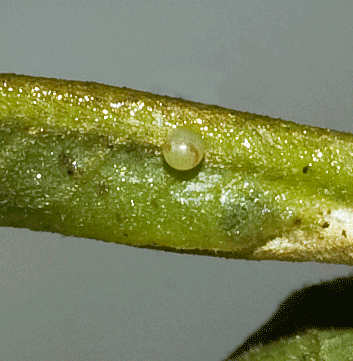Reproduction
A butterfly’s most
important goal in life is the same as every other sexual animal,
and that is to find a mate and have viable offspring. When
butterflies are searching for mates, it is often called a
flight. Since the Eurytides marcellus has such a large range
these flights vary between locations. In the north of its
range, there are two flights, and in the south, there are many.
The flights occur between the months of March and December. The
male butterflies look for a female mate around the host plant
(Hall and Butler 1998). Butterflies recognize each other by
color, size, pheromones, and shape (Wilson 2008).
Butterflies reproduce back
to back and are often found with the male’s wings between the
female’s wings. The male sends sperm into the abdomen of the female
where she stores it until she is ready to lay eggs. The eggs are
fertilized as the female lays the eggs (Wilson 2008). The female
lays her eggs on the host plant where she intends for her young to
eat and grow. The eggs of the zebra swallowtail are laid singly on
the young leaves of the plant (Damman and Feeny 1988). A hard outer
shell protects the eggs. On the inside of that shell, there is a
waxy layer that keeps the egg from drying out (Edwards 2008).

It is extremely important to the E. marcellus to lay their eggs on the correct plant. They are very picky about the plant that they lay their eggs on. For this species, that plant would be the North American Paw Paw tree. The females try to find the best tree for the larvae to feed on. They can often detect, without landing, if a tree is a Paw Paw or not and if the tree is in good health. If the butterfly touches a leaf, they will know right away if it is the Paw Paw or not (Damman and Feeny 1988).
However, this species is paying so much attention to the quality of the plant and not paying enough attention to the enemies that inhabit the same area. This enemy is often a spider, which the female butterfly seems to ignore. This does not end up well for the egg that she chooses to lay there. That being said, E. marcellus larvae do survive better on plants that females chose than ones they rejected (Damman and Feeny 1988).
There are chemical stimulants that the zebra swallowtail senses through chemoreceptors that help the butterflies know if they have found the right host plant. 3-caffeoyl-muco-quinic acid (3-CmQA) is this contact stimulant. It is present in the Paw Paw trees that this species of butterfly is looking for. However, the concentration of 3-CmQA is not the only concentration they are looking at. They also consider the concentrations of flavonoids. They can evaluate and contrast the chemical makeup of different leaves and trees to determine the place to lay their eggs (Haribal and Feeny 2002). This ovipositioning behavior of the E. marcellus is all to find a suitable food source for their young. Zebra swallowtails rely heavily on the chemical profile of a plant in order to accurately recognize the host plant by its CQA derivatives (Haribal, Feeny, and Lester 1998).
.jpg)